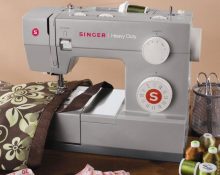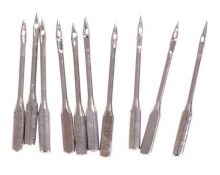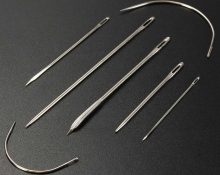The needle is one of the very first inventions of mankind; people invented it even before the wheel. And this is not surprising. Even today, in the age of high technology, it is in every home. It is impossible to imagine our life without this small item. In the article we will talk about what the first needles were like, when their mass production began and what they represent today.
The history of the needle
It is believed that this item has remained virtually unchanged since ancient times. Yes, needles used to be simpler, they were made from scrap materials, but they were always used exclusively for sewing.
For a long time they were made by hand, but during the opening of the first factories and factories, production became widespread.
First mentions
Scientists were unable to determine the exact date of the appearance of the needle. It is believed that this happened about thirty thousand years ago. However, there is no direct evidence of this fact - we are talking about the guesses of experts.
The “oldest” objects found by archaeologists that look similar to modern products were invented by humans approximately 17,000 years ago.On the territory of modern Russia, archaeologists have found needles that were made during the Late Paleolithic period (about 19,000 years ago).
There were no fabrics in those days. People made some kind of clothing from the skins of animals killed during hunting. Lianas were used instead of threads. Iron was also not known then, and therefore needles were made from fish and animal bones.

The first products were large and looked like an awl. Later, when man learned finer craftsmanship, the bones became thin; people planed them in such a way that one end was very sharp.
Bronze appeared later. Needles began to be made from this metal. Even then they were very small, so scientists assumed that in those days not vines, but horse hair were used as threads.

Iron needles appeared in the 3rd century BC. in the territory of modern Bavaria. They looked like a kind of hooks (they didn’t know the eye then, so they bent one end into a small ring).
In Ancient Greece they also knew how to sew, using iron needles. The Egyptians knew how to embroider already in the 5th century BC. The needles of the Egyptians of that time are very similar to the ones we use today.
The first steel needle was invented by the Chinese in the 10th century AD.
Middle Ages
Seafarers brought needles to European countries in the 8th century AD. It is assumed that they were sold to Europeans by people from Mauritanian tribes. According to other sources, travelers from Arab countries (trade between them and Europeans was well established).
In 1370, Damascus steel appeared, and many tools for sewing and small handicrafts began to be made from it. At the same time, the first workshop for the production of metal items for sewing appeared in Europe, but there was still no eyelet in the products of that time.Moreover, such small metal objects were expensive because they were forged by hand.
In the 12th century, Europeans learned to draw wire using a special plate. Thanks to this, the process of producing small metal objects has become cheaper. The appearance of the needles has also improved. They became thinner and smoother.
A real “revolution” in needlework took place in the 16th century in Nunberg (Germany). There they invented a hydraulic motor, and the drawing process was mechanized.
In the Middle Ages, they were produced not only in Germany. Many of them were produced in Spain. "Spanish Spades" needles (as they were called at that time) were very popular and were exported to other countries. True, these needles cost incredible amounts of money and were considered a luxury item. Rarely did a master of those years have more than two copies.
In the 16th century, the industrial revolution raged in England. The production of needles was concentrated in this state. The process was inexpensive, so needle prices dropped. Gradually they became an ordinary household item that almost every European family could afford.
In the 16th century, etchings became popular in Europe - a special type of painting in which a design was drawn with a needle on an engraving. It is noteworthy that the usual sewing accessory was not used. The design was made using a needle, although outwardly similar to a sewing needle, but without an eye. The tip of the etching tool was in the shape of a cylinder, cone, and even a spatula. The patterns were drawn on a metal plate coated with varnish. After applying the pattern, the plate was dipped in acid - it corroded the grooves, the pattern became distinct and very beautiful.

@artmajeur.
Interesting! Thanks to etchings, the world learned about such European artists as A. Durer, H. Riberu. In Russia, the production of such engravings was carried out by V.I.Bazhenov.
Mass production
In 1850, the first full-fledged needle machine appeared in England. Now all products were made with an eyelet. England came out on top in the production of this sewing accessory, literally captured the market and for a long time was practically the only major supplier.
Everything that came before was essentially handmade. The needles were made of wire; they quickly deformed and had to be changed frequently. England was able to put production on stream. From then to this day, these items have been mass produced.
In the twentieth century, more and more factories for the production of sewing equipment were opened - in almost every developed country, where sewing tools were made.
How are things today
It is impossible to imagine the modern world without sewing accessories. There are a lot of needles. They come specifically for machine and for hand sewing, different in length, width and eyelet size.
In stores you can find needles with which we sew wool or leather, very thin fabrics and boot soles. There are also standard needles that we use to repair clothes or embroider. In short, there are a lot of options, and only professional seamstresses can understand all this diversity.


 0
0





